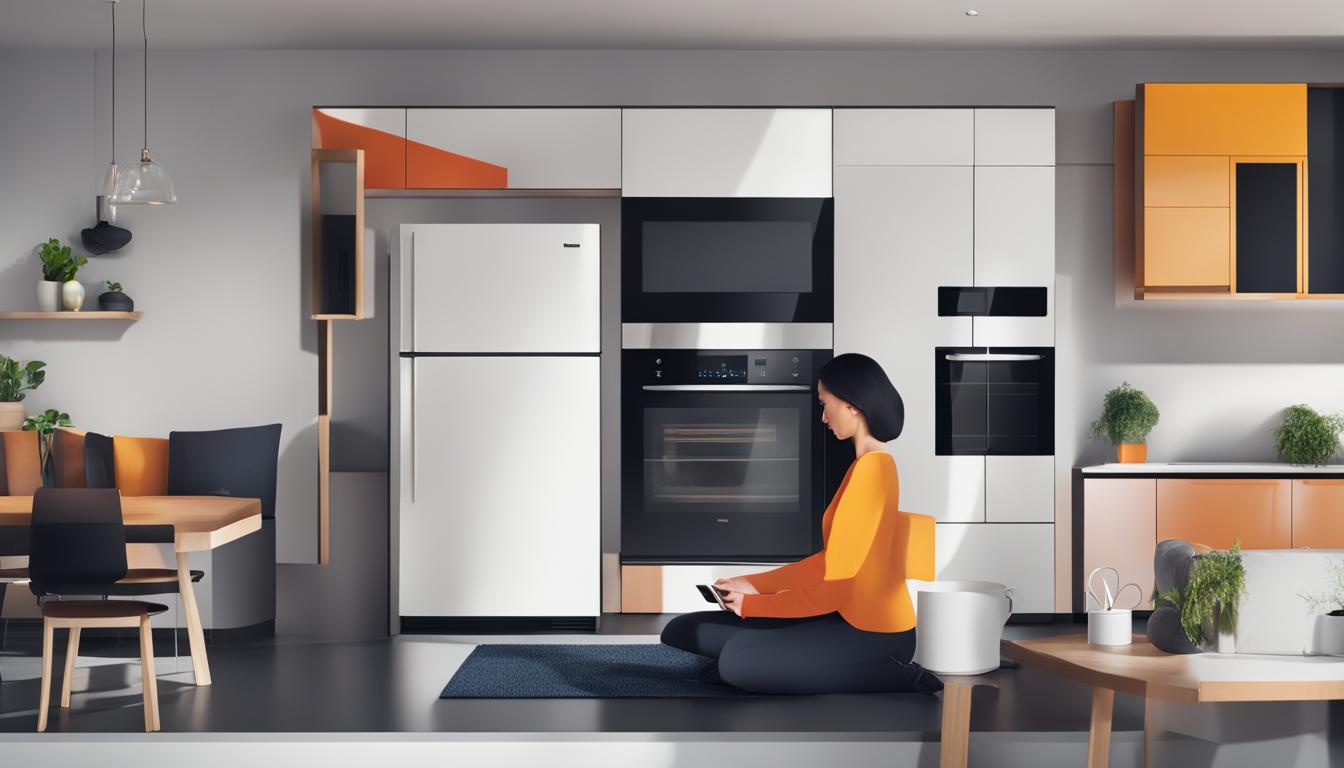Smart homes have revolutionized the way we live, bringing advanced technology and automation into our daily lives. But what exactly sets them apart from traditional homes? Let’s delve into the differences and discover the fascinating world of smart home technology.
In a traditional home, you rely on manual control for most of your household tasks. From adjusting the temperature to turning on the lights, everything requires your physical presence. Smart homes, on the other hand, offer a whole new level of convenience and efficiency through automation and remote control functionality.
Imagine a home where lights turn on automatically as you enter a room, or where you can control your appliances with a single tap on your smartphone. That’s the power of smart home technology.
But it doesn’t stop there. Smart homes are also designed with energy efficiency in mind. With programmable systems and energy-saving features, you can reduce energy waste and save money on your bills. And let’s not forget the enhanced security that smart homes provide, giving you peace of mind with advanced security systems and remote monitoring capabilities.
So, whether you’re intrigued by the convenience, energy efficiency, or security features, exploring the differences between smart homes and traditional homes is definitely worth your while.
Key Takeaways:
- Smart homes offer advanced technology and automation, providing convenience and efficiency.
- Automation and remote control functionality set smart homes apart from traditional homes.
- Energy efficiency is a key feature of smart homes, allowing for reduced energy waste and cost savings.
- Smart homes provide enhanced security features and remote monitoring capabilities.
- Exploring the differences between smart homes and traditional homes can help you make an informed decision about your living environment.
Level of Automation in Smart Homes
Smart homes offer a whole new level of automation compared to traditional homes. Home automation systems are at the heart of smart homes, enabling homeowners to control various aspects of their house with ease. From appliances to lighting, heating, and security systems, these smart devices for the home can be programmed to operate automatically without the need for manual intervention. This level of automation not only adds convenience to everyday life but also enhances efficiency by eliminating the need for manual control of individual devices.
With the advancement of technology, smart home automation systems have become more sophisticated, allowing homeowners to create personalized routines and schedules. For example, you can program your lights to turn on and off at specific times, adjust the temperature settings of your thermostat based on your daily routine, or even set your coffee maker to start brewing right before you wake up. These automated features make it easier than ever to manage and control your home, saving you time and effort.
To illustrate the level of automation in smart homes, let’s take a look at a comparative table:
| Features | Traditional Homes | Smart Homes |
|---|---|---|
| Manual control of devices | Yes | No, devices operate automatically |
| Customizable routines | No | Yes |
| Integration of multiple devices | Limited | Extensive |
| Remote access and control | Limited | Yes, using a smartphone or other devices |
As you can see, smart homes offer a significantly higher level of automation compared to traditional homes. The integration of multiple devices and the ability to customize routines and schedules make smart homes an innovative and convenient choice for homeowners seeking a more advanced living environment.
Remote Control Functionality in Smart Homes
One of the key features that sets smart homes apart from traditional homes is their remote control capabilities. With the advancement of smart technology, homeowners now have the ability to control various aspects of their homes from anywhere in the world, using a smartphone or other networked devices.
With the help of a smart home app, homeowners can easily manage and monitor their homes remotely. Whether it’s adjusting the lighting, setting the temperature, or managing security systems, all it takes is a few taps on the smartphone screen. This remote control functionality provides homeowners with convenience and peace of mind, allowing them to stay connected to their homes even when they’re away.
Smart Home App
The central component of remote control functionality in smart homes is the smart home app. This app serves as the interface between the homeowner and their smart home devices. It allows homeowners to access and control all connected devices from a single, user-friendly platform.
Through the smart home app, homeowners can create customized schedules for their devices, set up automation rules, and receive real-time notifications about their home’s status. For example, if a smart security camera detects motion, the homeowner will receive an instant alert on their smartphone.
Furthermore, the smart home app provides homeowners with the flexibility to control their home using voice commands. By integrating with virtual assistant technologies like Amazon Alexa or Google Assistant, homeowners can simply speak commands to their smart home devices, making the control process even more convenient and hands-free.
Smart Home Hub
In addition to the smart home app, smart homes often incorporate a central hub that acts as the brain of the system. The smart home hub serves as a central point for all devices to connect and communicate with each other.
With a smart home hub, homeowners can enjoy seamless integration and control over all their smart devices. The hub enables devices from different manufacturers to work together harmoniously, providing a unified and comprehensive smart home experience. This enhances the remote control functionality by allowing homeowners to control multiple devices simultaneously and create more complex automation scenarios.
Overall, the remote control functionality in smart homes revolutionizes the way homeowners interact with their living spaces. It offers convenience, flexibility, and peace of mind, empowering homeowners to have full control over their homes wherever they may be.
Energy Efficiency in Smart Homes
Energy efficiency is a key feature of smart homes that sets them apart from traditional homes. Smart homes incorporate various energy-saving features and smart appliances that help homeowners reduce their energy consumption and contribute to a more sustainable living environment.
Smart Home Appliances
One of the main contributors to energy efficiency in smart homes is the use of smart appliances. These appliances are designed to optimize energy usage by automatically adjusting their settings based on real-time data and user preferences. For example, smart thermostats can learn the homeowner’s schedule and adjust the temperature accordingly, ensuring optimal comfort while minimizing energy waste.
Furthermore, smart lighting systems in smart homes are equipped with features that allow homeowners to control and customize their lighting preferences. This includes the ability to adjust brightness levels, set timers, and even integrate with motion sensors to automatically turn off lights when no one is present in a room. By using these features, homeowners can significantly reduce energy consumption and lower their electricity bills.
Energy-Saving Features
In addition to smart appliances, smart homes incorporate a range of energy-saving features that further enhance their energy efficiency. These features include automated window shades that adjust based on the time of day and external weather conditions to regulate the amount of sunlight and heat entering the house.
Smart homes also utilize occupancy sensors that detect when a room is unoccupied and automatically adjust the temperature or turn off lights and appliances to conserve energy. By utilizing these energy-saving features, smart homes can effectively reduce wasted energy and create a more sustainable living environment.
| Energy Efficiency Features | Benefits |
|---|---|
| Smart thermostats | Optimizes temperature control, reducing energy waste and lowering utility bills. |
| Smart lighting systems | Allows for customized lighting preferences and motion-activated control, reducing unnecessary energy consumption. |
| Automated window shades | Regulates sunlight and heat entering the house, reducing reliance on heating and cooling systems. |
| Occupancy sensors | Automatically adjusts temperature and turns off lights and appliances when rooms are unoccupied, saving energy. |
Enhanced Security in Smart Homes
Security is a major advantage of smart homes over traditional homes. Smart homes are equipped with advanced security systems that provide enhanced protection for homeowners and their property. These systems offer a range of security features designed to keep homeowners safe and secure.
- Smart security cameras: Smart homes are equipped with high-definition cameras that can be accessed and monitored remotely. Homeowners can view live video feeds from their smartphones or other devices, allowing them to keep an eye on their property at all times.
- Remote monitoring: Smart security systems enable remote monitoring of the home, giving homeowners the ability to check on their property even when they are not physically present. This feature provides peace of mind and allows homeowners to respond quickly to any potential security threats.
- Smart locks: Traditional locks can be easily compromised, but smart homes use advanced lock systems that provide increased security. Smart locks can be controlled remotely, allowing homeowners to lock or unlock their doors from anywhere.
With these security features, smart homes offer homeowners greater control and visibility over the security of their property. The ability to remotely monitor and control the home provides peace of mind and ensures that homeowners can respond promptly to any security concerns that may arise.
| Security Features | Description |
|---|---|
| Smart security cameras | High-definition cameras that provide live video feeds and can be accessed remotely. |
| Remote monitoring | Allows homeowners to monitor their home remotely and respond quickly to potential security threats. |
| Smart locks | Advanced lock systems that provide increased security and can be controlled remotely. |

Convenience in Smart Homes
One of the key benefits of smart homes is the high level of convenience they offer to homeowners. With automation and centralized control capabilities, managing various aspects of the house becomes effortless. Homeowners can easily control lighting, temperature, and appliances through a smart home app or voice commands, eliminating the need for manual adjustment.
Centralized control allows for seamless management of multiple devices from a single interface, providing homeowners with a user-friendly experience. Whether it’s turning off the lights in every room with a single command or adjusting the thermostat from the comfort of the couch, the convenience of a smart home simplifies daily tasks and enhances comfort.
In addition, the convenience of smart homes extends beyond simple control. Smart home automation can be programmed to anticipate homeowners’ needs and preferences. For example, the system can learn when residents typically arrive home and automatically adjust the temperature and lighting accordingly. This level of personalized automation enhances convenience by ensuring a comfortable and welcoming environment upon arrival.
Convenience Features in Smart Homes:
- Centralized control through a smart home app or voice commands
- Automation that anticipates homeowners’ needs and adjusts settings accordingly
- Simplified management of multiple devices from a single interface
- Effortless control of lighting, temperature, and appliances
Table: Comparison of Convenience in Smart Homes and Traditional Homes
| Smart Homes | Traditional Homes | |
|---|---|---|
| Control Options | Centralized control through smart home app or voice commands | Manual control of individual devices |
| Automation | Can be programmed to anticipate homeowners’ needs | Manual adjustment required for each task |
| Efficiency | Effortless management of multiple devices from a single interface | Time-consuming task of adjusting each device separately |
| Comfort | Customized settings for a comfortable and welcoming environment | Limited control over the ambiance of the home |
As seen in the comparison table, smart homes offer a greater level of convenience compared to traditional homes. The centralized control, automation features, and simplified management provide homeowners with an effortless and tailored living experience. The convenience of smart homes is especially beneficial for individuals with mobility issues or elderly family members who may require assistance. By embracing smart home technology, homeowners can enjoy the convenience and comfort that this advanced living environment has to offer.
Benefits of Smart Homes
Smart homes offer a range of benefits compared to traditional homes. These benefits include increased energy efficiency, cost savings on energy bills, enhanced security and monitoring capabilities, convenience and ease of use, and customization options.
Energy Efficiency:
One of the key advantages of smart homes is their energy efficiency. By using advanced technology, smart homes can optimize energy usage and reduce waste. Smart thermostats, for example, can learn homeowners’ habits and adjust the temperature accordingly, saving energy and lowering utility bills. Additionally, smart lighting systems can automatically turn off when no one is in the room, further reducing energy consumption.
Convenience:
Smart homes offer unparalleled convenience and ease of use. Homeowners can control various aspects of their home, such as lighting, temperature, and appliances, using voice commands or smartphone apps. They can also automate routine tasks, such as turning on the lights or brewing a cup of coffee, saving time and effort. With centralized control, managing the entire home becomes effortless and user-friendly.
Security Features:
Enhanced security is another significant benefit of smart homes. Smart security systems offer advanced features such as real-time video monitoring and remote access, allowing homeowners to monitor their home from anywhere. Motion sensors and alarm systems can notify homeowners of any suspicious activity, providing them with peace of mind and an increased sense of security.
| Benefits of Smart Homes | Smart Home | Traditional Home |
|---|---|---|
| Energy Efficiency | Optimized energy usage through automation and intelligent systems | Higher energy consumption due to manual control |
| Convenience | Centralized control and automation for effortless management | Manual operation of various systems and appliances |
| Security Features | Advanced security systems with real-time monitoring and remote access | Traditional security measures without remote monitoring capabilities |
In addition to energy efficiency, convenience, and security, smart homes also offer customization options. Homeowners can tailor their smart home systems to meet their specific needs and preferences. Whether it’s choosing the desired lighting ambiance or creating personalized schedules for automated tasks, smart homes provide flexibility and control over the living environment.
Overall, the benefits of smart homes make them an attractive option for homeowners who desire a more efficient, convenient, and secure living experience. With advancements in technology and automation, smart homes continue to evolve and offer even more possibilities for the future.
Conclusion
In conclusion, smart homes offer a myriad of advantages that set them apart from traditional homes. With advanced automation capabilities, homeowners can enjoy the convenience of having various aspects of their home operate automatically. Whether it’s controlling the lighting, adjusting the temperature, or managing security systems, smart homes provide a level of comfort and efficiency that traditional homes cannot match.
Furthermore, the remote control functionality of smart homes allows homeowners to have complete control over their living environment, even when they are away. With a simple smartphone app or a smart home hub, individuals can monitor and manage their home from anywhere in the world, adding an extra layer of convenience and peace of mind to their lives.
Energy efficiency is also a significant differentiating factor. Smart homes are designed to optimize energy usage, reducing waste and saving homeowners money on their energy bills. By integrating energy-saving features and adaptable systems, smart homes contribute to a more sustainable and environmentally friendly living space.
Lastly, smart homes offer enhanced security features, giving homeowners greater control and peace of mind. With advanced security systems and real-time monitoring, individuals can keep a close eye on their property, ensuring the safety of their loved ones and belongings.
While traditional homes certainly have their merits, the unique combination of automation, remote control functionality, energy efficiency, and enhanced security makes smart homes a compelling choice. Ultimately, the decision between a smart home and a traditional home comes down to personal preferences and lifestyle needs. However, it’s clear that smart homes are shaping the future of residential living, offering a more advanced and customizable way to create a comfortable and efficient living environment.
FAQ
How do smart homes differ from traditional homes?
Smart homes differ from traditional homes in terms of features and technology. Smart homes are equipped with automation capabilities, allowing various aspects of the house to operate automatically without any input from the homeowner. They also offer remote control functionality, allowing homeowners to control their home using a smartphone or other devices. Additionally, smart homes provide enhanced security features and offer greater convenience for homeowners.
What is the level of automation in smart homes?
Smart homes are equipped with advanced home automation systems that allow for the automation of various aspects of the house. Appliances, lighting, heating, and other systems can be set to operate automatically, without the need for manual control. This level of automation provides homeowners with convenience and efficiency, as they can easily manage and control their home without having to physically interact with each device.
How does remote control functionality work in smart homes?
Smart homes offer a high level of remote control functionality. Homeowners can control various aspects of their home, such as lighting, heating, security systems, and appliances, using a smartphone or other networked devices. This remote control is made possible through a smart home app that integrates all the devices into a single interface. Smart home hubs, such as Amazon Echo or Google Home, act as the central point of the smart home system, allowing homeowners to control and monitor their home remotely from anywhere in the world.
Are smart homes more energy-efficient?
Yes, smart homes are designed to be more energy-efficient compared to traditional homes. This is achieved through the use of energy-efficient appliances and lighting systems. Smart systems can be programmed to operate more efficiently, reducing energy waste and saving homeowners money on their energy bills. For example, smart thermostats can learn the homeowner’s habits and adjust the temperature based on their schedule, helping to optimize energy usage. By integrating energy-saving features, smart homes contribute to a more sustainable and environmentally friendly living environment.
What security features do smart homes offer?
Smart homes are equipped with advanced security systems that provide enhanced protection for homeowners and their property. These systems can detect when someone enters the house and instantly alert the homeowner through their smartphone or other devices. Smart security cameras allow for real-time video monitoring, and homeowners can remotely monitor their home from anywhere, providing them with peace of mind. With smart security systems, homeowners have greater control and visibility over the security of their home.
How do smart homes provide convenience?
Smart homes offer a higher level of convenience compared to traditional homes. With automation and remote control capabilities, homeowners can save time and effort on mundane tasks. Centralized control allows for easy management of various aspects of the house, such as lighting, temperature, and appliances. Homeowners can control their home using voice commands or through a smartphone app, making it more convenient and user-friendly. The convenience of smart homes is especially beneficial for individuals with mobility issues or elderly family members who may require assistance.
What are the benefits of smart homes?
Smart homes offer a range of benefits compared to traditional homes. These benefits include increased energy efficiency, cost savings on energy bills, enhanced security and monitoring capabilities, convenience and ease of use, and customization options. The advanced technology and automation features of smart homes provide homeowners with a more comfortable and efficient living environment. Smart homes also offer greater flexibility in terms of customization, allowing homeowners to tailor their home to their specific needs and preferences.
 Skip to main content
Skip to main content


